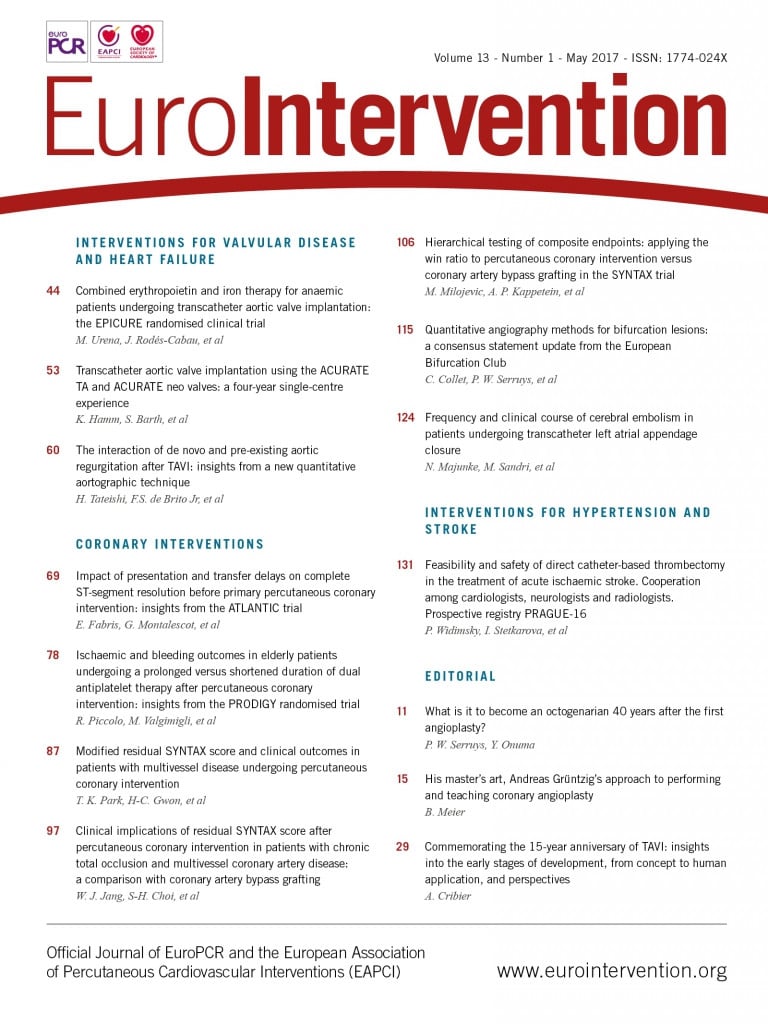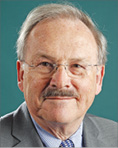
In 1985, four pioneers, Charles Dotter, Melvin Judkins, Mason Sones, and Andreas Grüntzig died in the same year. They have probably opened a wonderful diagnostic and interventional suite together in heaven (Moving image 1).
Andreas Grüntzig died on 27 October 1985. He and his wife Margaret Ann died in the crash of their twin-engined plane (Beechcraft Baron) in Forsyth, Georgia, USA, during a flight back from St. Simons Island to Atlanta. The pilot, Andreas Grüntzig, was probably caught by a storm coming from Mexico. I was told that he was flying it alone without a co-pilot for the very first time in his twin-engined plane and, like Icarus (from Greek mythology) flying high in the sky, he burned his wings “made of feather glued by wax” that melted in the sunshine... Andreas Grüntzig died young (46 years old) and, as many other famous people such as James Dean, Marilyn Monroe, John Kennedy or Bob Kennedy, he will remain in our memory as young, handsome, charismatic and iconic.
In the year 2000, I had the privilege to present the Andreas Grüntzig lecture at the European Society of Cardiology congress in Amsterdam. I entitled the lecture “If Andreas Grüntzig came back”. At the beginning of the lecture I was somewhat iconoclastic by trying to envisage what the ageing process would have done to the face of our pioneer (Figure 1). Today, 17 years later, I would not dare to depict how he would look like in 2017, and it is also impossible to surmise what Andreas would have achieved between 1985 and 2017. He certainly would have been involved in all the interventional endeavours that we have been through, such as atherectomy, laser, rotablator, stent, drug-eluting stent… and structural heart. By now, he would be almost an octogenarian (78 years old), like his first patient.
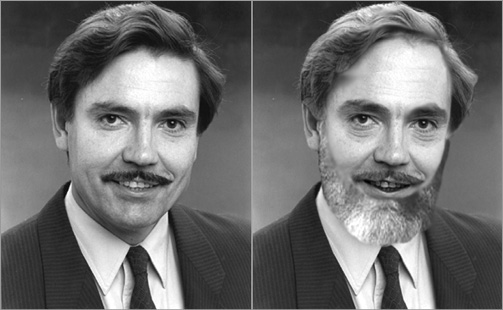
Figure 1. A slide shown during the Grüntzig lecture, in Amsterdam at the ESC congress in 2000, showing the simulated ageing process from 1978 (left) to 2000 (right). The authors did not apply the process further up to 2017.
There have been a few privileged collaborators who have been intimately associated with “the Andreas Grüntzig endeavour”. One of them is Bernhard Meier, who witnessed the historic moment when, on 16 September 1977, Andreas Grüntzig for the first time dilated a coronary stenosis in a conscious patient on the table of the cathlab. Later in his career, Andreas Grüntzig used to say that his legacy to medicine was to have been working on the human heart in a conscious patient. Thanks to the surgeon Åke Senning, he performed the first coronary angioplasty in a rather healthy patient aged 38 who today at 78 is still alive and kicking, although he is a very quiet and modest man. It is reassuring and encouraging for all of us to see that a patient can beat his coronary artery disease even if the onset of the disease is in the early phase of his life. I encourage you to read the historic account written by Bernie Meier in his inimitable style. You will certainly learn from a first-hand witness and a co-actor what it was to perform the first balloon angioplasty.
My recollection of these early days is much more modest.
My first encounter with Andreas Grüntzig was towards the end of the year 1976 in the Kempinski hotel in Frankfurt not far from the airport. I related that first encounter in an interview with John D. Rutherford published in Circulation1.
“Dr Rutherford asks: When you first heard that Andreas Grüntzig had successfully performed a transluminal coronary dilation in September 1977, what were your thoughts? Did it seem a sustainable therapy at the time?
Dr Serruys replies: In 1976 at a meeting in Frankfurt, a key opinion leader at that time, Professor Paul Lichtlen, Chief of Cardiology at Hannover, was describing during a keynote lecture a significant coronary lesion with a thin fibrous cap and a large atheromatous core; today, we call this a vulnerable plaque. He mentioned somewhat sarcastically that Dr Andreas Grüntzig had developed a procedure he believed could dilate that type of lesion. There was of course a lot of scepticism whether the procedure could be performed without major distal embolisation. I went to see Andreas Grüntzig and to look at his poster. He had tied a ligature with catgut around the coronary artery of a dog, and he was using his balloon to open this artificial narrowing. Honestly, I could not foresee the future of this therapeutic approach.”
How stupid I was…
In the spring of 1982, on his way back from Singapore and London, Andreas spent one day at the Thoraxcenter, and we at that time proudly showed him our interventional extravagancies: dilatation of the venous bypass graft, PTCA post thrombolysis2, treatment of CTO (Figure 2). In his wisdom and in an attempt to protect his technique, Andreas Grüntzig was gently but firmly critical of our extravagant treatments. Our first abstract on CTO reflected our immature behaviour at that time, but what a surprise it was at the AHA in November 1982 to see our abstract on CTO being accepted in the same session as the first abstract of Atlanta on CTO.

Figure 2. An abstract presented in 1982 at the 55th AHA scientific sessions. Please note that the guidewire used for the treatment of occlusion was a 0.035-inch guidewire for aortic use and that the so-called “soft guidewire” was in fact a 20 mm guidewire attached to the nose of the DG balloon catheter for a straight vessel, while DJ was for a curved vessel.
Alain Cribier is another giant pioneer who revolutionised our field of interventional cardiology. In 1986, he came to the Thoraxcenter in Rotterdam, to teach us how to do an aortic valvuloplasty in a spirit of interventional comradeship that today we would call more prosaically proctorship. At that time, the hype for this new development in cardiology was tremendous and the early disappointment – when it became evident that the treatment effect was just a transient “fix” - was huge. As a true pioneer, Alain Cribier did not accept the failure of the device and took it as a personal failure. He fought back and, as a true inventor and pioneer, pursued the urge to convert this transient fix into a permanent one. In 2002, he ushered the interventional community into a new era – the era of valve replacement. This new development occurred in a totally different environment from the first coronary balloon angioplasty. He had to treat an almost moribund patient, by compassion, and the smile of his first patient hours and days after procedure exemplified the fact that his patient was relieved by Alain’s treatment and again hopeful as to his survival (Figure 3). Readers please look carefully at the picture and you will detect these feelings expressed on his face. In 2004, Alain came back to the Thoraxcenter, this time to teach us how to perform an antegrade aortic valve replacement (Moving image 2). Over all these years, he has been a model for all of us, and today it is a pleasure to see him still actively involved in the interventional community. I strongly advise you to read his historic account of the development of valve replacement.
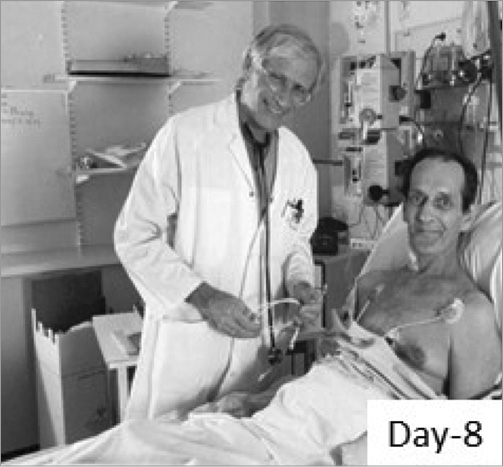
Figure 3. The first patient treated with percutaneous antegrade valve replacement by Dr Alain Cribier. The picture was taken eight days after the treatment.
Spencer King, another giant in interventional cardiology, succeeded in attracting Andreas Grüntzig (who was not satisfied by his academic position in Europe and by the slow expansion/adoption of his technique in Zurich) to the USA. He too was a witness of the early days of the technique (Figure 4). In the present issue, he has inaugurated a new rubric in the journal, called “Perspective”. “Perspective” will be an open forum where intervention key opinion leaders can voice and convey to our community their vision of the interventional world… or of the world in general without any fear or censorship by our editorial board. The first “Perspective” of Spencer King III published in our journal is brilliant; his helicopter view of what has happened over the last 40 years is a message of wisdom and intelligence.
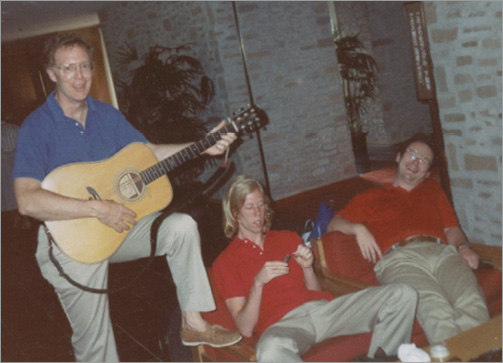
Figure 4. Spencer King III was singing the angioplasty blues; I convinced him that the stent would take over a balloon angioplasty. From left to right, Spencer King III, his son and Patrick W. Serruys (1993, in Mauna Kea beach hotel, Hawaii, at the meeting of the Interventional Society of South California, USA).
Last but not least, Adolf Bachmann –the first patient of Andreas Grüntzig– should not be forgotten, as he is the true hero in this historic development. His video testimony on his relationship and dialogue with Andreas Grüntzig is extremely touching and moving (Moving image 3). He explained that he decided to undergo this novel and experimental treatment because Dr Grüntzig, as he said, had described to him the first-in-man attempt to be carried out in such a detailed and clear manner. In 1977, informed consent was not yet formalised by ethics committees, and a patient had to trust just what the doctor was telling him. I have to share a secret with the readers of EuroIntervention: every year in the board meeting of EuroPCR, we have a secret vote about the individual who is going to be the next Ethica awardee. In my secret ballot, I put Mr Bachmann at the top of the list, being fully aware that my vote was unconventional and unrealistic. However, I sincerely believe that the community of patients who were, are and will be first-in-man are the real heroes in our modern medicine.
Conflict of interest statement
The authors have no conflicts of interest to declare.
Supplementary data
Moving image 1. In 1985, four pioneers in the interventional cardiology field passed away. A video from the DVD “PTCA: a history”. Reproduced with permission from angioplasty.org
Moving image 2. Cineangio of antegrade aortic valve replacement performed in 2004 by Dr Cribier at the Thoraxcenter in Rotterdam. The case was presented at the European Society of Cardiology in the same year.
Moving image 3. Interview with the first PTCA patient, Mr Bachmann. A video from the DVD “PTCA: a history”. Reproduced with permission from angioplasty.org. The full interview is availabe at the following link: http://www.ptca.org/voice/2012/09/16/35th
Supplementary data
To read the full content of this article, please download the PDF.
In 1985, four pioneers in the interventional cardiology field passed away. A video from the DVD “PTCA: a history”. Reproduced with permission from angioplasty.org
Cineangio of antegrade aortic valve replacement performed in 2004 by Dr Cribier at the Thoraxcenter in Rotterdam. The case was presented at the European Society of Cardiology in the same year.
Interview with the first PTCA patient, Mr Bachmann. A video from the DVD “PTCA: a history”. Reproduced with permission from angioplasty.org. The full interview is availabe at the following link: http://www.ptca.org/voice/2012/09/16/35th
